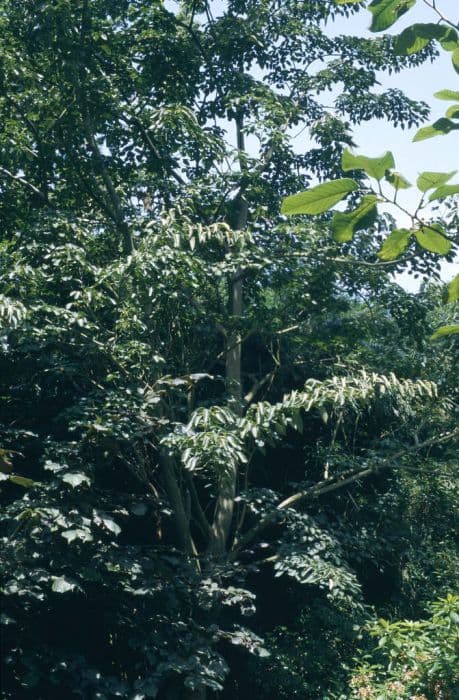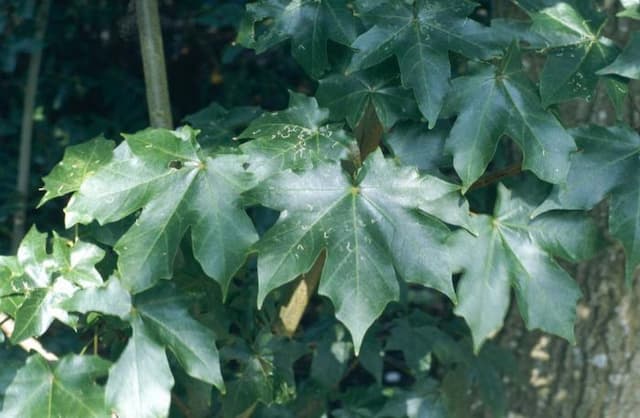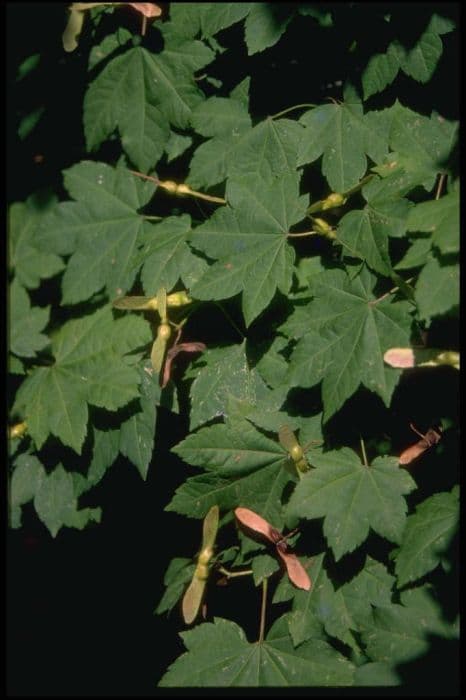Korean Maple Acer pycnanthum

ABOUT
Acer pycnanthum, commonly known as the Kobe Maple, features a distinctive and attractive appearance that makes it a favorite in gardens and landscapes where it fits the climate and space requirements, although these specifics are not to be elaborated upon. The leaves of the Kobe Maple are its most characteristic trait, displaying a broad triangular shape with pointed tips and serrated edges. Each leaf is attached to the branch by a long slender petiole, which allows some movement and fluttering in the breeze. In seasons of growth, the foliage presents a vibrant green, creating a lush canopy. The leaves are arranged in an opposite manner, which adds to the balanced look of the plant. As the seasons change, the Kobe Maple undergoes a dramatic transformation, with its leaves turning to brilliant shades of red, orange, and yellow, offering a stunning display of fall color before they fall off for winter. The Kobe Maple also boasts a noteworthy bark, which is smooth when the plant is young but grows increasingly rough and furrowed with age. Overall, the bark provides additional visual interest throughout the year, particularly in winter when the foliage is absent. Flowering is a subtle part of its appearance, with small and often inconspicuous blooms that may go unnoticed against the backdrop of the impressive foliage. The flowers are followed by winged seeds that spin like helicopters as they fall, a feature that is common to many maples and adds to its charm. Overall, the Kobe Maple is admired for its stunning seasonal foliage display and its delightful structure, which lends itself to a variety of garden settings, assuming that the size is appropriate for the chosen location.
About this plant
 Names
NamesSynonyms
Korean Maple, Purplebloom Maple
Common names
Acer pycnanthum.
 Toxicity
ToxicityTo humans
Acer pycnanthum, commonly known as the Korean maple, is not generally regarded as a toxic plant to humans. There is limited information on the toxicity of this specific maple species; however, most members of the Acer genus are not harmful. Ingesting parts of the plant typically does not result in poisoning or serious health consequences for humans.
To pets
Acer pycnanthum, or the Korean maple, is not widely known to be toxic to pets. Like in humans, the toxicity of this particular maple to animals such as dogs and cats is not well-documented. Many maples are not toxic, and ingestion is often not associated with severe symptoms. However, it's important to note that some other species of maple, such as the Red Maple (Acer rubrum), can be toxic to horses and possibly to other pets in large quantities. Owners should always observe pets for any adverse reactions after consuming plant material and consult a veterinarian if any symptoms arise.
 Characteristics
CharacteristicsLife cycle
Perennials
Foliage type
Deciduous
Color of leaves
Green
Height
20-30 feet (6-9 meters)
Spread
20-30 feet (6-9 meters)
Plant type
Tree
Hardiness zones
5
Native area
Japan
Benefits
 General Benefits
General Benefits- Ecosystem support: Acer pycnanthum, commonly known as Red Maple, provides habitat and food for various wildlife, including birds, squirrels, and insects.
- Ornamental value: With its vibrant fall foliage in shades of red and yellow, Red Maple is a popular choice for landscaping and ornamental use.
- Shade provision: Red Maple trees can offer significant shade for homes and parks, which can reduce energy costs by cooling the surrounding area.
- Soil improvement: Like many trees, Red Maple contributes to soil health through leaf litter, which decomposes and enriches the soil with nutrients.
- Carbon sequestration: Trees like the Red Maple play a role in climate mitigation by absorbing carbon dioxide from the atmosphere and storing carbon in their biomass.
- Erosion control: The extensive root system of Red Maple trees helps to stabilize soil and prevent erosion, particularly along stream banks and slopes.
- Seasonal interest: Red Maple provides visual interest throughout the seasons, from spring flowers to summer greenery and autumn color changes.
 Medical Properties
Medical PropertiesThis plant is not used for medical purposes.
 Air-purifying Qualities
Air-purifying QualitiesThis plant is not specifically known for air purifying qualities.
 Other Uses
Other Uses- Acer pycnanthum, commonly known as the Korean maple, can be utilized in woodworking projects, as the wood is often hard and versatile, suitable for furniture and intricate carving.
- The winged seeds of the Korean maple, known as samaras, are sometimes used in decorative crafts and jewelry, showcasing natural forms in artistic ways.
- Korean maple leaves undergo beautiful color changes in the fall, making them perfect subjects for photography and seasonal art projects that capture the essence of autumn.
- The bark of the Korean maple might be used in small-scale landscaping to create textured garden mulch that can help retain soil moisture and suppress weeds.
- Dried Korean maple leaves can serve as natural bookmarks, offering an organic and biodegradable option for readers who appreciate a touch of nature in their books.
- Korean maple trees can be grown as bonsai, providing a creative outlet for horticultural artistry and the cultivation of miniature landscapes.
- The distinctive leaf shape and vibrant colors of the Korean maple make it ideal for use in pressed leaf crafts, such as creating decorative wreaths or framed botanical art.
- Korean maple wood can be transformed into musical instruments, specifically woodwind instruments, where the wood's density can contribute to a richer sound.
- The sap of the Korean maple can be collected and studied as part of educational projects that explore the biology and ecology of trees, although it is not typically used for syrup like some other maple species.
- In landscape design, the Korean maple's striking foliage and form can serve as a natural privacy screen or windbreak when planted in rows or clusters.
Interesting Facts
 Feng Shui
Feng ShuiThe Acer pycnanthum, commonly known as the Korean Maple, is not specifically used in Feng Shui practice.
 Zodiac Sign Compitability
Zodiac Sign CompitabilityThe Korean Maple is not used in astrology practice.
 Plant Symbolism
Plant Symbolism- Strength and Endurance: As a species of maple, Acer pycnanthum, commonly known as the Korean maple, typically symbolizes strength and endurance due to its hardy nature and ability to withstand various climates and conditions.
- Wisdom: Similar to other maples, the Korean maple is often associated with wisdom, possibly due to its longevity and the intricate patterns of its leaves, which can evoke thoughts of complexity and insight.
- Beauty: The aesthetic appeal of the Korean maple's foliage, especially during autumn when it turns vibrant shades of orange and red, represents beauty and the appreciation of visual splendor in nature.
- Peace: The tranquil appearance of the maple tree, with its balanced and harmonious growth, can symbolize peace and serenity, offering a sense of calmness to those who observe it.
- Grace: The graceful form and movement of the maple's leaves in the breeze can symbolize elegance and grace, reflecting a gentle and refined quality.
 Water
WaterThe Korean maple, Acer pycnanthum, prefers consistently moist soil, so regular watering is important. Water the plant deeply once a week, providing about 1.5 gallons for medium-sized trees, ensuring the water penetrates the root zone. During hot or dry periods, you may need to water twice a week to maintain moisture. Reduce watering in the late fall and winter when the tree is dormant. Always check the soil moisture level before watering to avoid overwatering, which can lead to root rot.
 Light
LightThe Korean maple thrives in partial shade to full sun. It is best to plant it in a spot where it receives morning sunlight and afternoon shade, particularly in warmer climates, to protect it from the harsh afternoon sun. An ideal location would provide a few hours of direct light with dappled or filtered light during the peak sun hours.
 Temperature
TemperatureKorean maples prefer temperatures between 60°F and 80°F, which are ideal for growth and health. They can tolerate a minimum temperature of around -20°F for short periods once fully established. However, prolonged exposure to temperatures above 90°F may stress the plant, so it's important to provide some shade and ample water during extreme heat.
 Pruning
PruningPrune your Korean maple to remove any dead or damaged branches and to shape the tree for aesthetic purposes or to maintain size. The best time to prune is during late winter or early spring before new growth starts. Pruning should be done sparingly, as the Korean maple does not require extensive cutting back, and should be limited to once every couple of years unless there is a specific issue to address.
 Cleaning
CleaningAs needed
 Soil
SoilThe Kobe Maple prefers well-draining soil with a mix of loam, peat, and bark in equal parts to ensure aeration and moisture retention. The soil pH should ideally be between 5.5 and 6.5.
 Repotting
RepottingKobe Maple should generally be repotted every 2-3 years in spring before new growth begins, to refresh the soil and allow room for growth.
 Humidity & Misting
Humidity & MistingKobe Maple thrives best in moderate to high humidity levels, preferably around 60-70%, avoiding the drier conditions found in many homes.
 Suitable locations
Suitable locationsIndoor
Provide bright indirect light and avoid dry air for Kobe Maple.
Outdoor
Plant in partial shade with wind protection for Kobe Maple.
Hardiness zone
5-8 USDA
 Life cycle
Life cycleAcer pycnanthum, also known as Kyushu maple, begins its life cycle as a seed, which germinates in spring given appropriate moist and cool conditions. Seedlings establish a root system and a shoot that emerges above ground, and with sufficient light, water, and nutrients, the seedling develops into a young sapling. As the tree grows, it undergoes a juvenile phase where it increases in height and girth, developing characteristic palmate leaves that change color in autumn. The Kyushu maple reaches maturity after several years, at which point it begins to produce its own seeds encased in distinctive winged samaras that disperse in the wind. The reproductive stage can last for many decades, with the tree flowering annually in spring and continuing to grow and thicken its trunk. The plant eventually enters a senescent stage, marked by a decline in growth and reproductive output, until it dies, completing its life cycle.
 Propogation
PropogationPropogation time
Spring-Early summer
The most popular method of propagating Acer pycnanthum, commonly known as Korean maple, is through seed sowing. Seeds of the Korean maple should be collected in the autumn when they mature and change to a light brown color. The viability of seeds is highest if they are sown immediately after collection. However, these seeds often have a period of dormancy and may require stratification to enhance germination. Stratification involves simulating natural winter conditions by chilling the seeds for about 90-120 days at a temperature of 34-41 degrees Fahrenheit (1-5 degrees Celsius). After the cold stratification period, seeds can be sown in well-draining soil mix, ideally in a cold frame or greenhouse to protect them from extreme weather conditions. Germination can be slow and irregular, with seedlings emerging over several weeks to months.





![Freeman maple [Autumn Blaze]](/_next/image?url=https%3A%2F%2Fplants-admin.emdemapps.com%2Fimages%2Fplants%2F%2Fimages%2F604b575b84d87.png&w=640&q=75)



